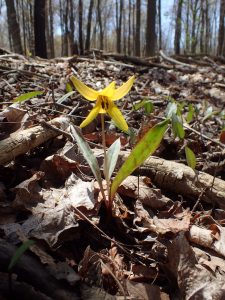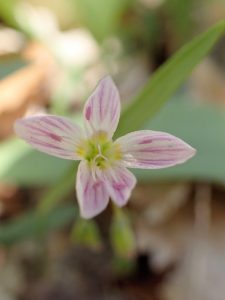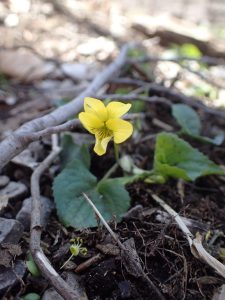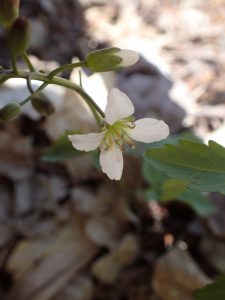Tag Archives: trout lily
Woodland Flowers
Trout lily, white trillium and red trillium are spring ephemeral flowers found in woodlands of the Northeastern United States. They grow best in moist, rich soil with a healthy leaf litter. These flowers take advantage of the abundance of sunlight reaching the forest floor during spring and grow when soil nutrients are high before the trees leaf out. All of these flowers are very sensitive to disturbance. They also have a special relationship with ants. Their seeds have a fatty nodule called an elaiosome which ants carry off to their colony for food. Seed dispersal by ants is called myrmecochory. Ants eat the eliaosome and the seeds are left to germinate underground. However, most of these flowers spreading happens underground through bulb or corm budding. Each spring you have a narrow 2 to 3 week window during April and May to enjoy the splendor of these beautiful woodland flowers. Once the tree canopy closes these flowers will have faded. They are beautiful and are protected in many areas, so please take only pictures.
Created by Mike Adriaansen
What’s Blooming at Reinstein Woods? National EE Week
As temperatures warm and days grow longer, Reinstein Woods has begun to pop with color. Red maple flowers polka dot the trails while the long yellow catkins of cottonwoods dance in the breeze. The true stars of the parade into spring are the wildflowers that reveal their beauty for a few short weeks before the greenwash is complete.
Early wildflowers are often referred to as “spring ephemerals” due to their short blooming period. These flowers appear before the emerging forest canopy blocks the majority of the sun from reaching the forest floor. In a few weeks these flowers grow, produce seeds and disappear. Each species has developed a unique set of tools to ensure the survival of their offspring. We’ve highlighted four native wildflowers that you can find on the trail this week.

Trout Lily (Erythronium americanum)
Where to find it: Beech Tree Trail, Lower Pond Trail
Trout lilies are easily identified by two mottled leaves covered in brown splotches with a flower rising out of a single stalk. The flower has six yellow tepals- three petals and three sepals- that curve backward exposing a cluster of stamens. It takes a trout lily up to seven years to develop a flower—if it does at all—and large parts of the forest floor at Reinstein are covered in colonies of immature plants marked by their singular mottled leaf. Underground, the plant spends years adding to a bulb of stored food. If a flower grows, the resulting seeds have a fatty deposit, or elaiosome, that attract ants who disperse the seed throughout the forest. This symbiotic relationship, called myrmecochory, is common among many spring wildflowers.

Spring Beauty (Claytonia virginica)
Where to find it: Beech Tree Trail
Hidden among a trout lily patch at Reinstein Woods is the delicate spring beauty flower. This white flower is streaked with brilliant pink and sits among grass-like leaves. These lines guide pollinators to the center of the plant. Spring ephemerals are an important source of food for many pollinating insects who find nectar and pollen scarce in the early spring.

Violets (Viola)
Where to find it: Lily Pond Loop, Beech Tree Trail
Many of our trails are lined with blue and yellow violets, flowers with five delicate petals and heart shaped leaves. Like the trout lily, these plants also attract ants to their seeds with fatty elaiosomes, but ensure a wide range of travel with an exploding seed pod that shoots seeds up to ten feet away.

Two-leaf Toothwort (Cardamine diphylla)
Where to find it: Lower Pond Trail
This member of the mustard family can be identified by its four white petals and two opposite leaves divided into three leaflets.
See if you can spot all four of these wildflowers on your next visit to Reinstein Woods!
Nature Sightings at Reinstein Woods
 The ice and snow have melted at Reinstein Woods, and signs of spring are all around. Quaking aspen and red maples are beginning to flower. Spotted salamanders (pictured) have made their way to woodland pools to lay their eggs. A chorus of spring peepers, chorus frogs, and leopard frogs can be heard along pond edges as you walk through the preserve. Wildflowers are beginning to sprout and soon the forest floor will be green with life. Trout lilies are showing their mottled green leaves. A patch of bloodroot is already flowering, but most of their blossoms remain wrapped in their leafy cloak. Mourning cloak butterflies are seen perched on sunlit logs and leaves on the ground. Green Darner dragonflies have completed their journey north. On warm, sunny days they lay their eggs in ponds at Reinstein Woods.
The ice and snow have melted at Reinstein Woods, and signs of spring are all around. Quaking aspen and red maples are beginning to flower. Spotted salamanders (pictured) have made their way to woodland pools to lay their eggs. A chorus of spring peepers, chorus frogs, and leopard frogs can be heard along pond edges as you walk through the preserve. Wildflowers are beginning to sprout and soon the forest floor will be green with life. Trout lilies are showing their mottled green leaves. A patch of bloodroot is already flowering, but most of their blossoms remain wrapped in their leafy cloak. Mourning cloak butterflies are seen perched on sunlit logs and leaves on the ground. Green Darner dragonflies have completed their journey north. On warm, sunny days they lay their eggs in ponds at Reinstein Woods.
Are you interested in what’s happening on the trails of Reinstein Woods? Check back periodically for updates on “Nature Sightings at Reinstein Woods”. Feel free to leave a comment below if you would like to add your own wildlife sighting.

